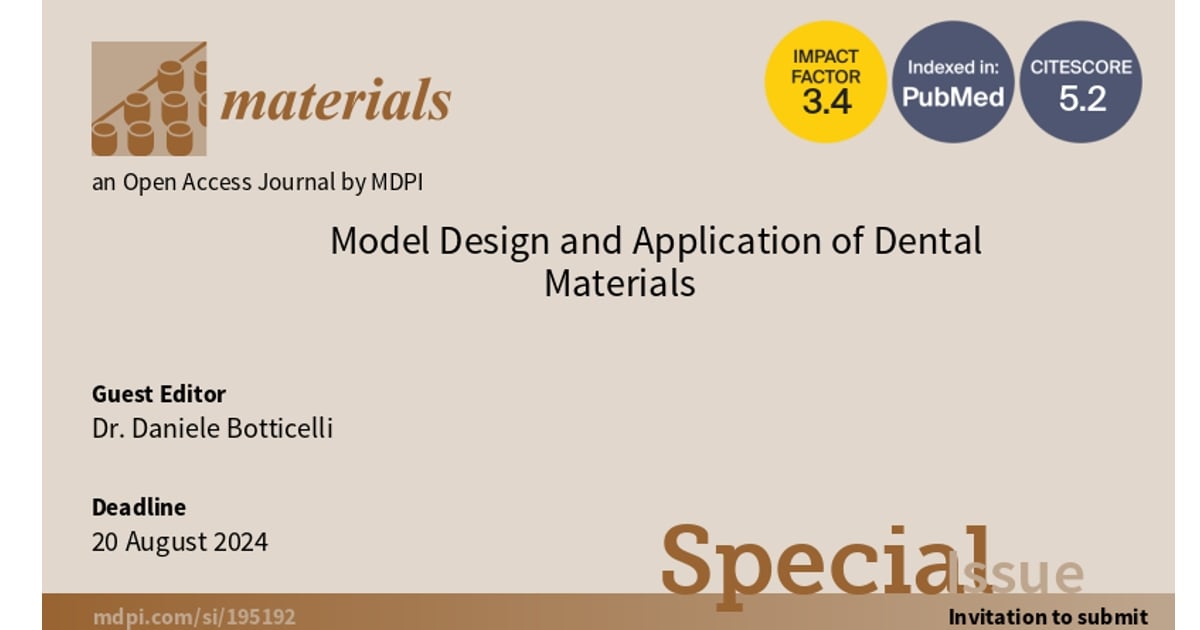Model Design and Application of Dental Materials
A special issue of Materials (ISSN 1996-1944). This special issue belongs to the section "Biomaterials".
Deadline for manuscript submissions: closed (20 August 2024) | Viewed by 2161

Special Issue Editor
Interests: dental implant; oral surgery; sinus floor elevation; bone volume augmentation; histology
Special Issues, Collections and Topics in MDPI journals
Special Issue Information
Dear Colleagues,
In recent years, there has been a growing interest in dental materials as they play a crucial role in the development of effective dental treatments. The application of advanced materials, such as ceramics, polymers, and composites, has revolutionized dental practices and improved patient outcomes.
To further support the advancement of dental materials, this Special Issue welcomes submissions on various aspects related to the model design and application of dental materials. Models have become a widely used experimental method in dentistry, and new ideas are needed regarding the use of models for dental research. By exploring the properties and performance of models, and providing new designs, researchers can provide valuable insights into the development of innovative solutions for dental challenges.
We encourage scholars to take this opportunity to contribute to the discourse surrounding dental materials. This Special Issue provides a platform for researchers to share their expertise, engage in collaborative discussions, and ultimately expand the knowledge in this field.
Dr. Daniele Botticelli
Guest Editor
Manuscript Submission Information
Manuscripts should be submitted online at www.mdpi.com by registering and logging in to this website. Once you are registered, click here to go to the submission form. Manuscripts can be submitted until the deadline. All submissions that pass pre-check are peer-reviewed. Accepted papers will be published continuously in the journal (as soon as accepted) and will be listed together on the special issue website. Research articles, review articles as well as short communications are invited. For planned papers, a title and short abstract (about 100 words) can be sent to the Editorial Office for announcement on this website.
Submitted manuscripts should not have been published previously, nor be under consideration for publication elsewhere (except conference proceedings papers). All manuscripts are thoroughly refereed through a single-blind peer-review process. A guide for authors and other relevant information for submission of manuscripts is available on the Instructions for Authors page. Materials is an international peer-reviewed open access semimonthly journal published by MDPI.
Please visit the Instructions for Authors page before submitting a manuscript. The Article Processing Charge (APC) for publication in this open access journal is 2600 CHF (Swiss Francs). Submitted papers should be well formatted and use good English. Authors may use MDPI's English editing service prior to publication or during author revisions.
Keywords
- dental materials
- dental implant
- constitutive model
- dental casts
- orthodontics
Benefits of Publishing in a Special Issue
- Ease of navigation: Grouping papers by topic helps scholars navigate broad scope journals more efficiently.
- Greater discoverability: Special Issues support the reach and impact of scientific research. Articles in Special Issues are more discoverable and cited more frequently.
- Expansion of research network: Special Issues facilitate connections among authors, fostering scientific collaborations.
- External promotion: Articles in Special Issues are often promoted through the journal's social media, increasing their visibility.
- Reprint: MDPI Books provides the opportunity to republish successful Special Issues in book format, both online and in print.
Further information on MDPI's Special Issue policies can be found here.






